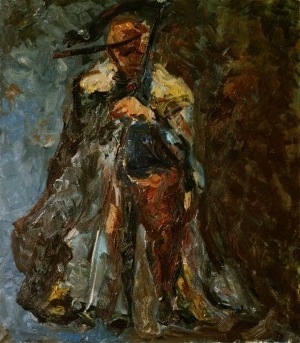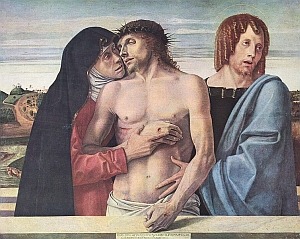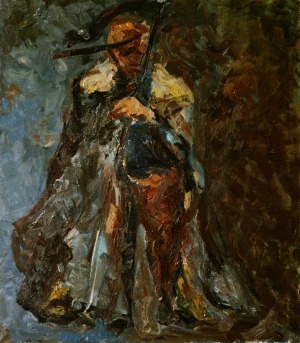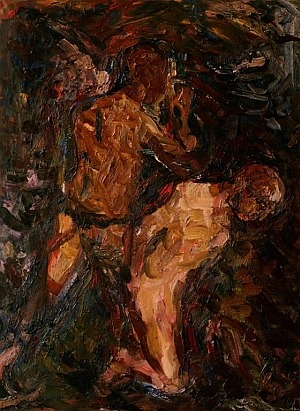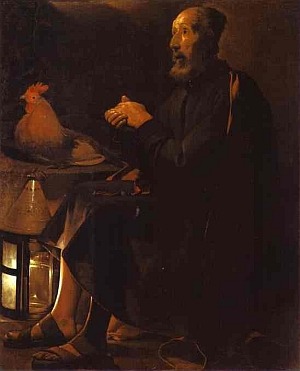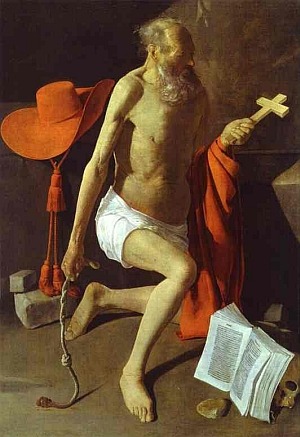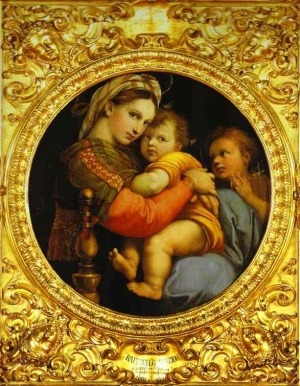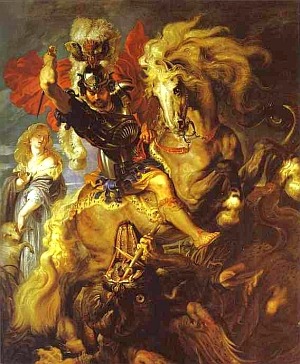SAINTS HELP TO ENRICH PAINTINGS WITH LIGHT AND BEAUTY 1
Rūta Marcinkevičiūtėwww.kamane.lt , 2010 03 31Sigita MaslauskaitėIn brief: The exhibition of paintings of Sigita Maslauskaitė opened at Pamėnkalnio Gallery in Vilnius suited the Lent term perfectly. It is not often than we can see high-quality paintings on religious themes today. Repentance, pain, martyrdom. A big part of works are paintings of saints.According to the art critic Raminta Jurėnaitė, “The baseline for Sigita Maslauskaitė is canvases of ancient Renaissance and Baroque masters. She rephrases the monumental style of their figures by painting her saints in restless and dashing strokes." R.Jurėnaitė sees dramatic mysticism in the religious paintings of the 39-year-old artist, and this mysticism distinguishes the works of S.Maslauskaitė in the panorama of Lithuanian as well as global new painting.
S.Maslauskaitė. St.Hieronymus
S.Maslauskaitė. St.Jacob
S.Maslauskaitė. Tears of St.Peter
S.Maslauskaitė. MartyrdomThe artist admitted in one interview several years ago that “it is fearful to paint saints as all masterpieces have already been painted”. Still, the exhibition testifies that more and more saints appear in her works every year. Therefore, as the exhibition is coming to an end and St. Easter is approximating, the artist was interviewed about saints, their images and our relation with them.The conversation deviated to the relations of the religious and lay world as S.Maslauskaitė is not only a painter, but also an art critic and the director of the Church Heritage Museum open at Vilnius St. Michael Church. After completing painting studies at Vilnius Academy of Arts in 1996, she studied church heritage at Rome Gregorian University in 1997–2000. Later she continued post-graduate studies of Christian iconography at Vilnius Academy of Arts and defended the doctor’s thesis “The Cult and Iconography of St. Casimir in the 16th Century – Beginning of the 19th Century” in 2006. This year the Lithuanian National Museum published the extensive study of S.Maslauskaitė “The Story of Picturing St. Casimir in the 16th-18th Century“. Still, St. Casimir is not among saints painted by her yet.“The saints are important for painting and for another field of my activity: studies of Christian iconography in Baroque art. Although I try analysing artworks as an art critic, I often look at them as a painter. I evaluate colours, forms, relations. It is not an accident that there is much of brown colour, red and gold in my works. I have looked much at paintings of Rembrandt, Caravaggio, various other Baroque masters. The colours and drama, the chiaroscuro, expression of their paintings is close to me. Also, I enjoy works of Georges de La Tour, whose paintings are not expressive but there is much of tempting secret in them,” the artist reveals her favourite artists.
Georges de La Tour. Tears of St.Peter
Georges de La Tourr. Repentance of St.HieronymusThe artist and art critic S.Maslauskaitė tells in the interview that the idea to paint saints appeared in 2003: the first saint, St. George was painted in this year. Like all artists, she wanted to paint in light and beautiful manner. As she never succeeded to do this, the idea occurred that the plot could save her black and brown works.“Painting is the only field in which I feel a professional. I love it from my childhood, and I studied for a long time. Now the period of creation started which is related with saints: one or another appears constantly. Still, if somebody ordered a painting for the altar, I would become scared. If I decided to paint it, it could be painful as I would start asking myself whether I am worth doing it, whether I should paint in one or another manner. Meanwhile, when I paint in my workshop and create paintings for the exhibition, the most important is that it is a good painting, no matter if it is a saint or some landscape,” the artist speaks about her work.Speaking about the difference between religious and lay art, S.Maslauskaitė states that religious art is art dedicated for piety. Also, there exist artworks, paintings, sculptures, etc., which may be admired but one will never have an idea to kneel down at them or light a candle. The artist believes that the authorship of an artwork is a sign that it is not a religious work. From the times of Renaissance, there exists the difference between a work created by an artist and a religious object created by an anonymous author, e.g. icons or similar works. Although the authors of famous icons are often known."Here is an example from art history: candles are not lit at any Madonna of Raphael in any country of the world. It is art of the highest quality, but it is not religious art as regards piety," the artist points out.
Raphael. Sitting Madonna
Rembrandt. Jacob's Fight with an Angel
Rubens. St.George and Dragon“If I had to remember which artwork has moved me purely religiously, I would mention “Pieta” by Giovanni Bellini. The painting is showcased in Milan Brera Art Gallery and not in some church. I know that it was dedicated to piety some time ago; however, it moved me not due to this reason. It was simply possible to feel the religious persuasiveness of this work, no matter that the work had the author with a name and the times were secular already,” S.Maslauskaitė tells.
Giovanni Bellini. PietaS.Maslauskaitė does not want to call her works religious art due to the reason that she does not feel worth painting to the Church and also due to the low quality of religious works that are often placed in churches. Perhaps such are the needs of the church community: perhaps a painting should be understandable to a grandmother and a small child in parish churches? Still, the artist states to feel her blood boil in veins when she sees primitive works in churches. "I am a member of the religious community too, and why should I tolerate dull, low quality works appearing in churches today; why others cannot wait until some “unusual” work, which has artistic value, will start speaking to the community?“ the artist questions.Catholics longing for artistic quality of religious pictures are constantly reminded: “Don’t worry, it is only a reflection, not the Mother of God or Jesus Christ.” Yes, we all know that an artwork is only a bridge, a reminder, help in prayer, indication to a Person. Why isn’t this applied to everybody? Cheap art hurts people; it is the same as to listen to a badly performed composition for a person who has an ear for music.
